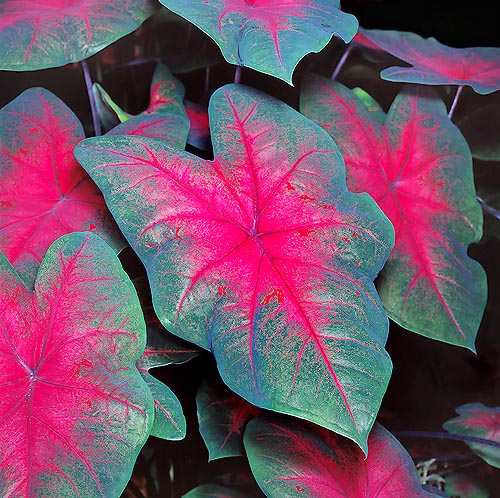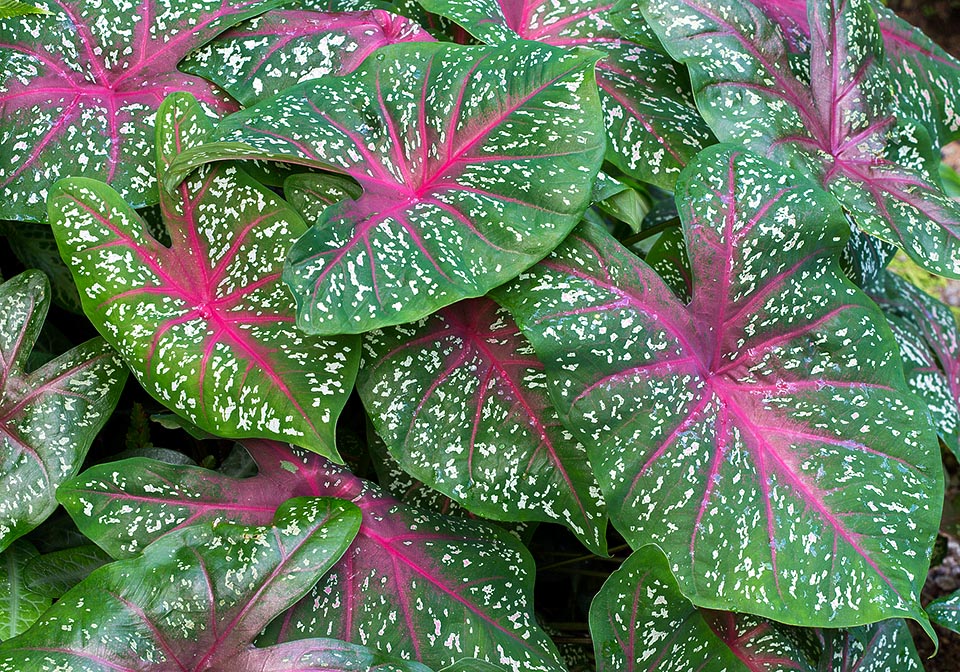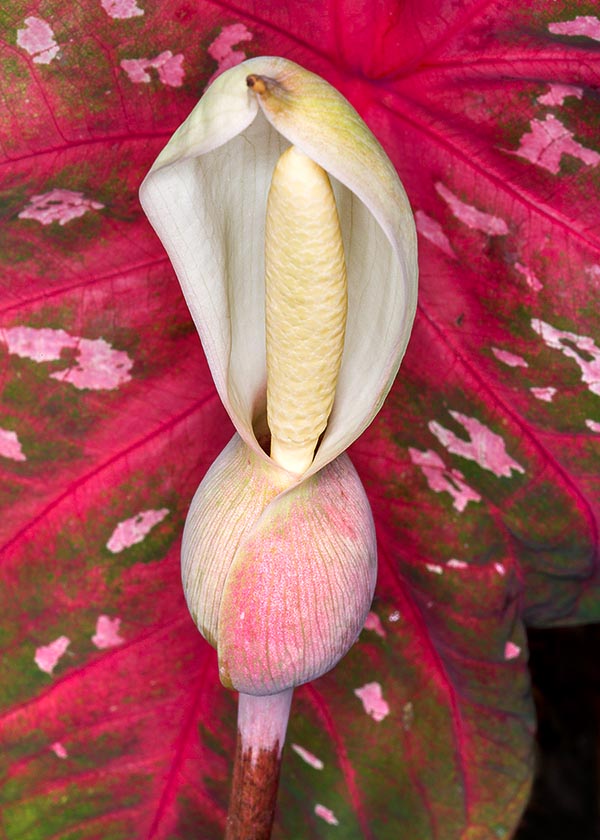Family : Araceae

Text © Pietro Puccio

English translation by Mario Beltramini

Negligible inflorescences, showy leaves and difficult cultivation © Giuseppe Mazza
The Caladium bicolor (Aiton) Vent. (1801) is native to the open forests of tropical South America (Brazil, Colombia, French Guyana, Guyana, Surinam and Venezuela), in areas characterized by evident seasonal changes.
It seems that the name of the genus is the Latinization of the name in Malay language “kaladi”; the name of the species comes from the Latin “bicolor” = of two colours, with obvious reference.
Common names: “caladio”, “caladium” (Italian); “angel wings”, “elephant’s ear”, “fancy-leaf caladium”, “heart-of-Jesus”, “mother-in-law plant” (English); “caladium”, “palette de peintre” (French); “caladio”, “coração-de-Jesus”, “papagaio”, “tajà”, “taià”, “tajurà”, “tambatajà”, “tinhorão” (Portuguese); “alas de angel”, “caladio”, “capotillo”, “corazon de Jesus”, “manto de la reina”, “orejas de elefante”, “paleta de pintor” (Spanish); “Buntblatt”, “Buntwurz”, “Kaladie” (German).
Deciduous, rhizomatous, perennial herbaceous, with peltate, sagittate or hart-shaped leaves, of various tones of green and variously spotted, veined and dotted of red, pink and white, 20-40 cm long and 10-20 cm broad on fleshy petioles, long up to about 60-70 cm, directly from the rhizomes.
The inflorescences, rather negligible and shorter than the leaves, are formed by a 6-10 cm long spadix, narrowed in the median part, contained in a yellowish white spathe tending to the green at the base; the flowers are unisexual, the male ones occupy the upper part of the spadix for 3-5 cm of length, the female ones are grouped in the lower part for 1-2 cm of length, separated from the male ones by a sterile zone of about 2 cm.
The fruits are whitish berries containing several seeds. It reproduces by division, in portions with at least two buds, by the end of the resting time, by seed, or micro-propagation in vitro. Plant of great ornamental value due to its foliage richly and variously coloured, it is permanently cultivable in open spaces in the tropical and subtropical climates on soils rich of organic substance, draining, tending to be acid, kept constantly humid during the vegetative time, in partially shaded location and sheltered from the wind.

Countless hybrids and varieties of Caladium bicolor adorn the tropical gardens and the indoor spaces as apartment plant © Giuseppe Mazza
The plant, more particularly its countless hybrids and varieties, is also cultivated, since long time, in pot for indoor decoration, paying attention to keep constantly humid the substratum during the vegetative period, and to stop completely watering during the resting time, when the plant loses its leaves, and resuming them after the vegetative recommencement.

The 6-10 cm spadix reminds us the belonging to the Araceae family © Giuseppe Mazza
Synonyms: Arum bicolor Aiton (1789); Arum pulchrum Salisb. (1796); Caladium poecile Schott (1832); Caladium haematostigma Kunth (1841); Caladium pallidum K. Koch & C.D. Bouché (1853); Caladium smaragdinum K. Koch & C.D. Bouché (1853); Caladium surinamense Miq. (1853); Caladium fermulum Schott (1854); Caladium marginatum K. Koch & C.D. Bouché (1854); Caladium marmoratum Mathieu ex K. Koch (1854); Caladium concolor K. Koch (1857); Caladium argyrospilum Lem. (1858); Caladium hastatum Lem. (1858); Caladium brongniartii Lem. (1858); Caladium chantinii Lem. (1858); Caladium houlletii Lem. (1858); Caladium neumanni Lem. (1858); Caladium perrieri Lem. (1858); Caladium verschaffeltii Lem. (1858); Caladium troubetzkoyi Hérincq (1858); Caladium purdieanum Schott (1859); Caladium sororium Schott (1859); Caladium spruceanum Schott (1859); Caladium vellozianum Schott (1859); Caladium barraquinii Lem. (1860); Caladium belleyenei Lem. (1860); Caladium enkeanum K. Koch (1861); Caladium laucheanum K. Koch (1861); Caladium stangeanum K. Koch (1861); Caladium devosianum Lem. (1862); Caladium macrophyllum Lem. (1862); Caladium regale Lem. (1862); Caladium lemaireanum Barraq. (1862); Caladium picturatum C. Koch (1862); Caladium porphyroneuron K. Koch (1862); Caladium mirabile Lem. (1863); Caladium bicolor fo. poecile (Schott) Engl. (1879); Caladium bicolor fo. vellozianum Engl. (1879); Arum vermitoxicum Vell. (1881); Caladium steudneriaefolium Engl. (1885); Caladium adamantinum L. Linden (1890); Caladium medio-radiatum L. Linden & Rodigas (1890); Caladium sagittatum L. Linden & Rodigas (1890); Caladium bicolor var. roseo-maculatum Engl. (1920); Caladium bicolor var. surinamense (Miq.) Engl. (1920); Cyrtospadix bicolor (Aiton) Britton & P.Wilson (1924); Caladium bicolor var. vermitoxicum (Vell. ex Kunth) Stellfeld (1950); Caladium hortulanum Birdsey (1951); Caladium × hortulanum Birdsey (1951); Caladium bicolor fo. rubicundum Stehlé (1976); Caladium bicolor fo. surinamense (Miq.) Stehlé (1976).
